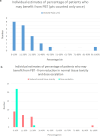Estimating the percentage of patients who might benefit from proton beam therapy instead of X-ray radiotherapy
- PMID: 35220723
- PMCID: PMC10993980
- DOI: 10.1259/bjr.20211175
Estimating the percentage of patients who might benefit from proton beam therapy instead of X-ray radiotherapy
Abstract
Objectives: High-energy Proton Beam Therapy (PBT) commenced in England in 2018 and NHS England commissions PBT for 1.5% of patients receiving radical radiotherapy. We sought expert opinion on the level of provision.
Methods: Invitations were sent to 41 colleagues working in PBT, most at one UK centre, to contribute by completing a spreadsheet. 39 responded: 23 (59%) completed the spreadsheet; 16 (41%) declined, arguing that clinical outcome data are lacking, but joined six additional site-specialist oncologists for two consensus meetings. The spreadsheet was pre-populated with incidence data from Cancer Research UK and radiotherapy use data from the National Cancer Registration and Analysis Service. 'Mechanisms of Benefit' of reduced growth impairment, reduced toxicity, dose escalation and reduced second cancer risk were examined.
Results: The most reliable figure for percentage of radical radiotherapy patients likely to benefit from PBT was that agreed by 95% of the 23 respondents at 4.3%, slightly larger than current provision. The median was 15% (range 4-92%) and consensus median 13%. The biggest estimated potential benefit was from reducing toxicity, median benefit to 15% (range 4-92%), followed by dose escalation median 3% (range 0 to 47%); consensus values were 12 and 3%. Reduced growth impairment and reduced second cancer risk were calculated to benefit 0.5% and 0.1%.
Conclusions: The most secure estimate of percentage benefit was 4.3% but insufficient clinical outcome data exist for confident estimates. The study supports the NHS approach of using the evidence base and developing it through randomised trials, non-randomised studies and outcomes tracking.
Advances in knowledge: Less is known about the percentage of patients who may benefit from PBT than is generally acknowledged. Expert opinion varies widely. Insufficient clinical outcome data exist to provide robust estimates. Considerable further work is needed to address this, including international collaboration; much is already underway but will take time to provide mature data.
Figures





Similar articles
-
Hitting the Target: Developing High-quality Evidence for Proton Beam Therapy Through Randomised Controlled Trials.Clin Oncol (R Coll Radiol). 2024 Feb;36(2):70-79. doi: 10.1016/j.clon.2023.11.027. Epub 2023 Nov 8. Clin Oncol (R Coll Radiol). 2024. PMID: 38042671 Review.
-
Proton beam therapy: perspectives on the National Health Service England clinical service and research programme.Br J Radiol. 2020 Mar;93(1107):20190873. doi: 10.1259/bjr.20190873. Epub 2020 Jan 14. Br J Radiol. 2020. PMID: 31860337 Free PMC article. Review.
-
Hadrontherapy for cancer. An overview of HTA reports and ongoing studies.Recenti Prog Med. 2019 Dec;110(12):566-586. doi: 10.1701/3278.32516. Recenti Prog Med. 2019. PMID: 31909760 Review. English.
-
Proton beam therapy in rectal cancer: A systematic review and meta-analysis.Surg Oncol. 2021 Sep;38:101638. doi: 10.1016/j.suronc.2021.101638. Epub 2021 Jul 27. Surg Oncol. 2021. PMID: 34340196
-
Normal Tissue Complication Probability Modelling for Toxicity Prediction and Patient Selection in Proton Beam Therapy to the Central Nervous System: A Literature Review.Clin Oncol (R Coll Radiol). 2022 Jun;34(6):e225-e237. doi: 10.1016/j.clon.2021.12.015. Epub 2022 Jan 15. Clin Oncol (R Coll Radiol). 2022. PMID: 35042622 Review.
Cited by
-
Proton beam therapy in multimodal treatment for locally advanced squamous cell carcinoma of the nasal cavity and paranasal sinus.Radiat Oncol. 2023 Jun 29;18(1):106. doi: 10.1186/s13014-023-02296-3. Radiat Oncol. 2023. PMID: 37386495 Free PMC article.
-
Risk of temporal lobe necrosis between proton beam and volumetric modulated arc therapies in patients with different head and neck cancers.Radiat Oncol. 2023 Sep 21;18(1):155. doi: 10.1186/s13014-023-02344-y. Radiat Oncol. 2023. PMID: 37735389 Free PMC article.
-
Failure patterns of locoregional recurrence after reducing target volumes in patients with nasopharyngeal carcinoma receiving adaptive replanning during intensity-modulated radiotherapy: a single-center experience in China.Radiat Oncol. 2023 Nov 16;18(1):190. doi: 10.1186/s13014-023-02373-7. Radiat Oncol. 2023. PMID: 37974274 Free PMC article.
-
Proton therapy (PT) combined with concurrent chemotherapy for locally advanced non-small cell lung cancer with negative driver genes.Radiat Oncol. 2023 Nov 16;18(1):189. doi: 10.1186/s13014-023-02372-8. Radiat Oncol. 2023. PMID: 37974211 Free PMC article.
-
Efficacy and safety of particle therapy for inoperable stage II-III non-small cell lung cancer: a systematic review and meta-analysis.Radiat Oncol. 2023 May 22;18(1):86. doi: 10.1186/s13014-023-02264-x. Radiat Oncol. 2023. PMID: 37217970 Free PMC article.
References
-
- Langendijk JA . Current status of particle therapy in the netherlands . Radiotherapy and Oncology 2016. ; 118: S65 . doi: 10.1016/S0167-8140(16)30132-3 - DOI

